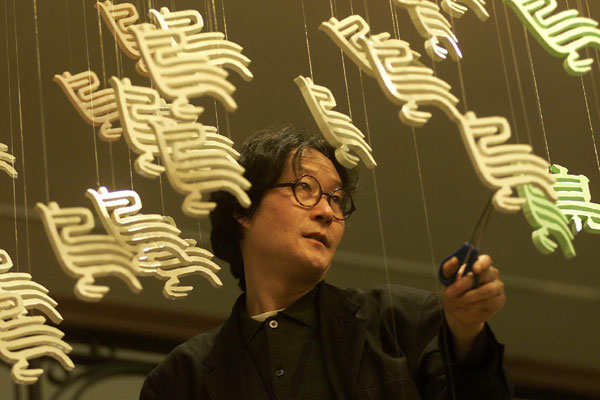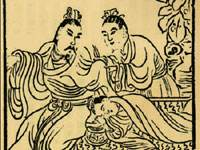
Xu is "exploring the fallout of the radical and jaw-droppingly rapid development of the Beijing skyline," the museum director says. "He's interested in both how these big luxurious buildings get made, and the stories of the laborers who build them. You feel all of that when you're looking at these raw, powerful pieces.
"He's bringing our attention back to the ground.
"On the other hand, in choosing the phoenix, and knowing how stories and both Western and Eastern mythologies are conflated, it's not entirely critical. There is something truly glorious about their upward flight. They're like stars - they shine."
Xu's birds were ultimately never installed in the commercial atrium. The financial crisis of 2008 left developers with "a limited sense of humor", he says. They feared the work might be too critical or ironic in light of their sudden financial difficulties.
Phoenix eventually appeared outside Beijing's Today Art Museum, and at the 2010 Shanghai Expo. The Massachusetts museum - in North Adams, near the state's western border with New York - is the first non-Chinese site to house the installation.
The Mass MoCA exhibition also features other works by the artist, including a vertical light box that replicates a Qing Dynasty (1644-1911) landscape. At first, the piece appears to be a traditional ink painting, but it is revealed to have been rendered in trash and debris when viewed from behind. The idea that things aren't what they seem sets a tone for both Xu's work and the exhibition, Thompson says.
The choice to exhibit Phoenix at Mass MoCA is particularly meaningful because of the building's history, Thompson says.
In the late 1800s North Adams experienced a manufacturing boom, briefly making it the biggest Chinese-immigrant city east of the Mississippi River. The building that now houses Mass MoCA was leased as a fabric-printing factory, employing hundreds of Chinese immigrants who helped produce knockoffs of European fashions.
"This site has a complex transcontinental relationship to what was going on in the Far East," Thompson says.
"I'm a firm believer that when you're trying to understand complex international relationships, artists are the most interesting people to listen to."
 |
|
"This work carries with it a flavor of China, the smell and the realities of the country today. It is full of concern about the lowest levels of Chinese society. " --XU BING artist. [Photo by Gao erqiang/China Daily] |
Xu, who lived in the United States for almost 20 years and whose 2011 installation Where Does the Dust Itself Collect? is about the Sept 11 terrorist attacks, believes Phoenix wouldn't have been possible had he not moved back to China in 2008.
"Only in this moment of China's rise could I have been moved to make work like this," he says. "If I had stayed in the US I wouldn't have felt so strongly.
"This work carries with it a flavor of China - the smell and the realities of the country today. It is full of concern about the lowest levels of Chinese society, and it's my way of acknowledging the practice of very poor people using the lowest materials to dress themselves with great self-respect.
"That is the heart of Chinese folk art: using the cheapest materials to create something that is unrealizable in daily life."
"My hope is that American audiences will see these phoenixes bearing scars, but proudly and with a great sense of self-respect, flying forward," Xu says. "I want them to feel a sense of the power and creativity that we have as a people."
Contact the writer at kdawson@chinadailyusa.com.

|

|